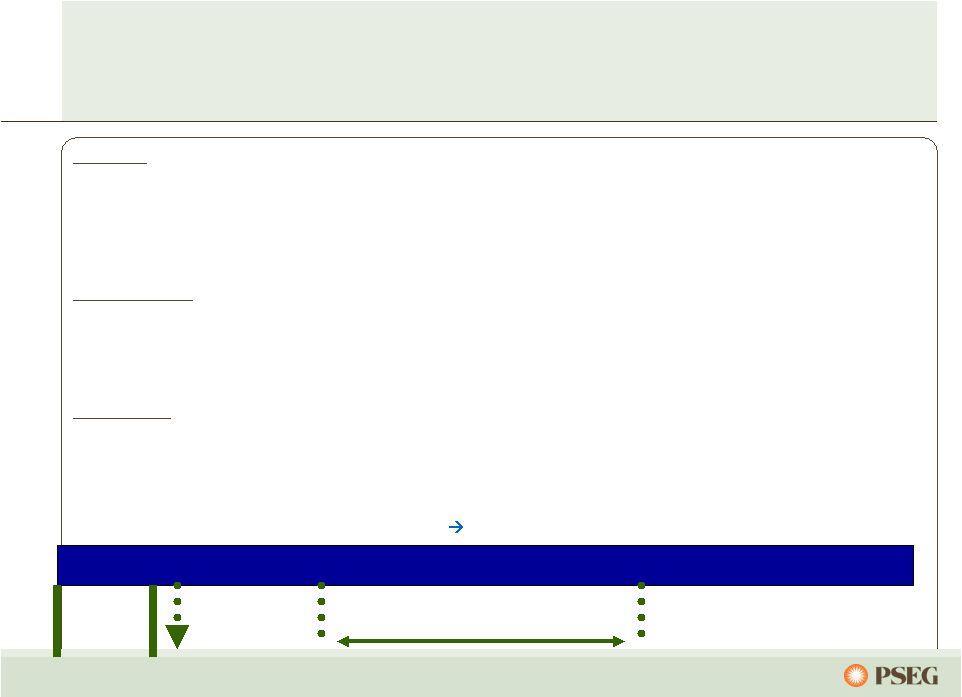- PEG Dashboard
- Financials
- Filings
-
Holdings
- Transcripts
- ETFs
- Insider
- Institutional
- Shorts
-
8-K Filing
Public Service Enterprise (PEG) 8-KRegulation FD Disclosure
Filed: 29 Jun 10, 12:00am
 Navigating the Environmental Regulatory Landscape Overview of Forthcoming National Environmental Requirements, Impacts to the Electric Power Industry, and PSEG Power’s Position June 29 - 30, 2010 Exhibit 99.1 |
 Forward-Looking Statement Readers are cautioned that statements contained in this presentation about our and our subsidiaries' future performance, including future revenues, earnings, strategies, prospects and all other statements that are not purely historical, are forward-looking statements for purposes of the safe harbor provisions under The Private Securities Litigation Reform Act of 1995. Although we believe that our expectations are based on reasonable assumptions, we can give no assurance they will be achieved. The results or events predicted in these statements may differ materially from actual results or events. Factors which could cause results or events to differ from current expectations include, but are not limited to: • Adverse changes in energy industry law, policies and regulation, including market structures and rules and reliability standards. • Any inability of our transmission and distribution businesses to obtain adequate and timely rate relief and regulatory approvals from federal and state regulators. • Changes in federal and state environmental regulations that could increase our costs or limit operations of our generating units. • Changes in nuclear regulation and/or developments in the nuclear power industry generally that could limit operations of our nuclear generating units. • Actions or activities at one of our nuclear units located on a multi-unit site that might adversely affect our ability to continue to operate that unit or other units located at the same site. • Any inability to balance our energy obligations, available supply and trading risks. • Any deterioration in our credit quality. • Availability of capital and credit at commercially reasonable terms and conditions and our ability to meet cash needs. • Any inability to realize anticipated tax benefits or retain tax credits. • Changes in the cost of, or interruption in the supply of, fuel and other commodities necessary to the operation of our generating units. • Delays or unforeseen cost escalations in our construction and development activities. • Increase in competition in energy markets in which we compete. • Adverse performance of our decommissioning and defined benefit plan trust fund investments, and changes in discount rates and funding requirements. • Changes in technology and increased customer conservation. For further information, please refer to our Annual Report on Form 10-K, including Item 1A. Risk Factors, and subsequent reports on Form 10-Q and Form 8-K filed with the Securities and Exchange Commission. These documents address in further detail our business, industry issues and other factors that could cause actual results to differ materially from those indicated in this presentation. In addition, any forward-looking statements included herein represent our estimates only as of today and should not be relied upon as representing our estimates as of any subsequent date. While we may elect to update forward-looking statements from time to time, we specifically disclaim any obligation to do so, even if our internal estimates change, unless otherwise required by applicable securities laws. |
 Increasingly stringent environmental requirements could significantly impact the electric power industry within the next decade. Major areas where new regulations are currently under development: • Management of Coal Combustion Residuals (CCRs) – Proposed new rule governing the use and disposition of coal combustion by-products under the Resource Conservation and Recovery Act (RCRA). • Clean Air Transport Rule (CATR) – The forthcoming CATR represents a court-mandated revision to the Clean Air Interstate Rule (CAIR) regulating sulfur dioxide (SO2) and nitrogen oxides (NOx) emissions under the Clean Air Act. • Hazardous Air Pollutants (HAPs) Maximum Achievable Control Technology (MACT) – Forthcoming court-mandated rule that will require coal- and oil-fired steam electric generating units to meet emissions limits for mercury (Hg) and other hazardous air pollutants (HAPs) pursuant to Section 112 of the Clean Air Act. • 316(b) Cooling Water Regulations – Forthcoming rule that will define how best available technology requirements for cooling water intake structures will be applied to large existing electric generating plants under Section 316(b) of the Clean Water Act. • Carbon Legislation / Greenhouse Gas (GHG) Best Available Control Technology (BACT) – Congress may move to establish a carbon cap-and-trade system to reduce GHG emissions from power plants. – Absent Congressional pre-emption, EPA is developing guidance that will inform how States determine BACT requirements for GHG emissions at major new and modified power plants under the Clean Air Act. |
 Management of Coal Combustion Residuals (CCRs) Overview: • TVA’s coal ash spill in December 2008 prompted EPA action to regulate the management and disposition of CCRs. • On June 21, 2010, EPA published a proposed rule identifying options to regulate coal ash and scrubber waste: • Option 1: coal ash and scrubber waste, when destined for disposal in landfills or surface impoundments, is subject to regulation as a hazardous waste under subtitle C of RCRA. • Option 2: coal ash and scrubber waste regulated under subtitle D of RCRA as a non-hazardous waste. Industry Impact: • Under both options, facilities with wet ash ponds would be required to expend capital to close or upgrade their ponds (including dam safety, liners, groundwater monitoring) and upgrade from wet to dry ash handling. • Many coal facilities will likely face higher variable operating costs due to heightened requirements for coal ash management and disposal. • Units that are unable to justify the capital investment or bear an increase in variable operating costs may be forced into retirement. • Unit retirements and/or increased variable operating costs are expected to lead to higher electricity prices. PSEG Power: • PSEG already utilizes dry ash handling and disposal systems. • PSEG coal ash and scrubber waste tested as non-hazardous. • PSEG has established options for beneficial re-use. 2010 2011 2012 2013 2014 2015 2016 2017 2018 2019 2020 Rule Proposed Rule Finalized EPA Comment Period Market Impacts Expected Likely Effective Date of requirement to close and/or upgrade existing wet ash ponds |
 Clean Air Transport Rule (CATR) 2010 2011 2012 2013 2014 2015 2016 2017 2018 2019 2020 Rule Proposed Rule Finalized EPA Comment Period Market Impacts Expected Likely Effective Date Overview: • Following the December 2008 US District Court remand of CAIR, EPA is expected to propose the CAIR-replacement Clean Air Transport Rule (CATR) by mid-summer 2010. • EPA and States must limit emissions of nitrogen oxides (NOx) and sulfur dioxide (SO2) in the eastern U.S. to meet the ozone and National Ambient Air Quality Standards (NAAQS). • As a replacement to the above, Congress may move to establish emissions limits for NOx and SO2 [as well as mercury (Hg)] by enacting a multi-pollutant revision to the Clean Air Act. Industry Impact: • CATR, or new legislation, will establish NOx and SO2 emissions limits on a plant-by-plant, State, or regional basis. • Implementation may force plants to retire or invest capital to control emissions. • Retirements and/or increased variable operating costs are expected to lead to higher electricity prices. PSEG Power: • PSEG has no anticipated capital expenditure exposure to CATR. • PSEG has highly controlled coal facilities with low NOx and SO2 emissions which position PSEG Power well relative to competitors. |
 Hazardous Air Pollutants (HAPs) Maximum Achievable Control Technology (MACT) 2010 2011 2012 2013 2014 2015 2016 2017 2018 2019 2020 Rule Proposed Rule Finalized EPA Comment Period Market Impacts Expected Likely Effective Date EPA Information Collection Request Overview: • EPA is under an adjudicated consent decree to establish MACT standards to reduce mercury (Hg) and other Hazardous Air Pollutants (HAPs) emissions at coal- and oil-fired steam electric generation units (EGUs). Industry Impact: • The MACT standards for Hg and other HAPs will establish emissions limits that will likely require uncontrolled coal and oil-fired steam units to expend capital to install emissions controls, or force them to retire. • The combination of capacity retirements and increased variable operating costs at facilities that install controls is expected to lead to higher electricity prices. PSEG Power: • While the MACT standards have not yet been established, PSEG Power’s affected units are in a good position to comply with the new emissions limits: – Mercer and Hudson will have fully installed emissions controls by the end of 2010. – Bridgeport Harbor has Hg controls but may require additional controls for other HAPs. – Keystone, 23% owned by Power, is highly controlled and has been tested to meet anticipated MACT standards. – Conemaugh, 23% owned by Power, is undergoing analysis and testing to determine if planned additional emissions controls are necessary. |
 316(b) Cooling Water Regulations Overview: • Pursuant to section 316(b) of the Clean Water Act, EPA is in the process of developing a rule that will define how States will establish standards for cooling water intake structures at large power plants. • The rule will apply to large existing power plants that are designed to withdraw 50 million gallons per day or more and that use at least 25 percent of their withdrawn water for cooling purposes only. – The rule will apply to 422 fossil-fueled and 38 nuclear power plants representing over 308 and 52 GW of existing capacity, respectively. • Concurrently, States such as NY and CA have begun to develop their own guidance with respect to cooling water intake structures at large power plants. Industry Impact: • Power plants that are located on tidal rivers, estuaries, or the Great Lakes – and which withdraw significant amounts of water – may face heightened risks to potential new requirements to install cooling water towers. • A requirement to install cooling towers will force power plants into a retrofit-or-retire decision. • Retirements and/or increased variable operating costs at facilities that install cooling towers are expected to lead to higher electricity prices. |
 316(b) Cooling Water Regulations (cont’d.) PSEG Power: • PSEG Power shares general industry exposure to potential new cooling water requirements at Hudson, Mercer, Bridgeport Harbor and most notably, at our Salem nuclear generating station. • However, in issuing permits for Salem, the NJ Department of Environmental Protection previously judged that Power has the Best Technology Available: – Salem has state of the art traveling screens to limit impingement, and entrainment, of fish. – Power has spent over $150M on an estuary enhancement program, yielding a nearly four-fold replacement of fish biomass lost at Salem. – Depending on the outcome of EPA’s final rule, cost / benefit considerations may limit Power’s Capex exposure. 2010 2011 2012 2013 2014 2015 2016 2017 2018 2019 2020 Rule Proposed Rule Finalized EPA Comment Period Market Impacts Expected Likely Effective Date of potential requirement to install cooling water towers |
 Overview: • Congress may move to establish a carbon cap-and-trade system to reduce GHG emissions from power plants. • Absent Congressional pre-emption, pursuant to a 2007 US Supreme Court ruling and EPA’s finding that GHGs threaten the public health and welfare, EPA is required to regulate GHG emissions under the Clean Air Act. – EPA is in the process of defining guidance for how States should implement BACT requirements during the permitting of major new and modified power plants, effective January 2011. Industry Impact: • A carbon cap-and-trade would increase variable operating costs for fossil-fueled power plants, especially coal. – Increased variable costs for generators are expected to lead to higher electricity prices. • In the meantime, GHG BACT requirements may delay and/or impede the permitting of new and modified power plants. – Delayed capacity additions or expansions may result in capacity constraints which could lead to increased electricity prices. PSEG Power: • As a result of its low carbon fleet, PSEG Power would realize a net benefit from a carbon cap-and-trade that establishes a price on carbon. • PSEG Power believes it has limited exposure to GHG BACT requirements. 2010 2011 2012 2013 2014 2015 2016 2017 2018 2019 2020 EPA Comment Period Market Impacts Expected Effective Date of GHG BACT Requirements EPA to define GHG BACT Guidance Anticipated Effective Date of federal carbon cap-and-trade on power plants. Carbon Legislation / Greenhouse Gas (GHG) Best Available Control Technology (BACT) |
 Conclusions • EPA is engaged in several significant, concurrent rule-makings that have the potential to shape the economics of electricity supply over the 2010-2020 time horizon. • The net outcome of these multiple rule-makings is unknown. However, the likely effect will be to force capital expenditure or retirement decisions at a significant share of the nation’s coal and oil-fired generation capacity. In addition, variable operating costs are expected to rise at most fossil-fueled power plants due to increased environmental requirements. • The various environmental initiatives under development are estimated to put 20 GW to 150 GW of existing fossil capacity at risk of retirement. • PSEG may be affected by some new requirements, but is generally well-positioned relative to industry peers. |